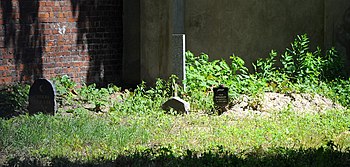Caucasian Islamic Cemetery (Warsaw)
The Caucasian-Islamic Cemetery (also: Muslim-Caucasian Cemetery , Polish: Muzułmański Cmentarz Kaukaski ) is a former Islamic cemetery on Ulica Młynarska 58/60 in the Warsaw district of Wola . The facility, which is only around 1,000 square meters in size, borders the large Jewish cemetery in the north and the Evangelical-Augsburg cemetery in the south .
history
The cemetery is the older of two Islamic burial places in Warsaw. In 1830 the plot of land for the cemetery was acquired by the Warsaw Evangelical-Augsburg Congregation for 2152 rubles . Islamic soldiers of the Russian army stationed in Congress Poland and Polish merchants of Islamic faith were buried here. The cemetery was used until 1867; after only 37 years it had to be closed due to overcrowding. A follow-up plant ( Tatar-Islamic cemetery ) was built just a few hundred meters from him.
During the Warsaw Uprising , it was severely damaged in the heavily contested area. The battalions “Wigry” and “Antoni” of the Polish Home Army were deployed near the cemetery and were involved in battles with German units.
Today the abandoned cemetery is a walled meadow. Among the few remaining tombstones are those of Jan Murza Tarak Buczacki († 1851, translator of the Koran into Polish) and Zachariasz Kieński († 1857, general). The complex was placed under monument protection on June 7, 1992 (number 1523).
literature
- Julius A. Chroscicki and Andrzej Rottermund, Architectural Atlas of Warsaw , 1st edition, Arkady, Warsaw 1978, p. 172
- Grzegorz Piątek, Jarosław Trybuś, Warsaw. The thematic guide through Poland's capital , Kamil Markiewicz (Uebers), ISBN 978-3-89728-070-0 , Schröder, Verlag für Regionalkultur, Diepholz 2009, p. 241 f.
Web links
Coordinates: 52 ° 14 ′ 36 ″ N , 20 ° 58 ′ 11 ″ E

